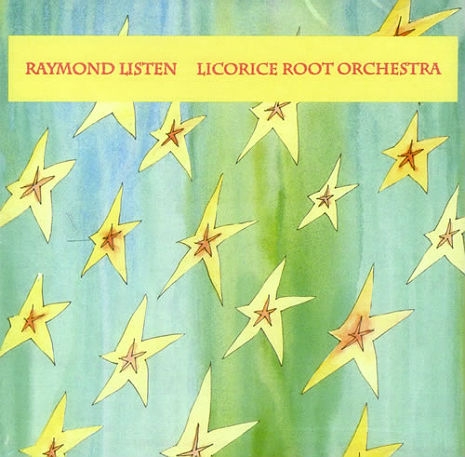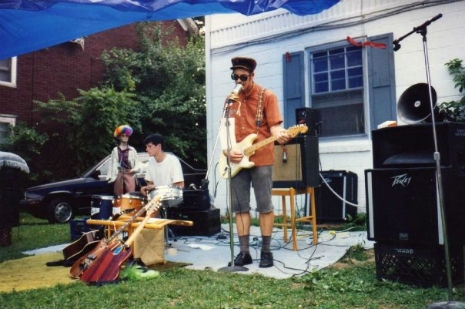
Last week Jeff Feuerzeig, the director of Half Japanese: The Band That Would Be King and The Devil and Daniel Johnston emailed to thank me for turning him on to the Licorice Root Orchestra album. He was referring to an old DM post about the cult band Raymond Listen (aka Licorice Roots). I took a look at that old post—I think it’s one of the greatest obscure gems that we’ve ever shown a spotlight here on DM and I was disappointed to see that the YouTube counters on their videos have barely budged since that post originally went up. And that pissed me off, so here it is again. Maybe a few more of you will pick up on it this time. Trust me, kids, this one is a real treat.
*If I’d have only mentioned Raymond Listen or the Licorice Roots in the title, would you even be reading this? Probably not, right? And who could blame you? Even by obscure band standards, they’re still pretty damned obscure. Obscure to the point where pretty much no one has ever heard of them. That’s why I made the Neutral Milk Hotel comparison up front, to draw you in (For some of you, admit it, I had you at “Neutral M…”). Stay with me here, though. You will be glad you did.
Still, it’s not really that egregious of a blog “bait-n-switch” title thing, either, because if you are a fan of Neutral Milk Hotel’s classic 1998 album In the Aeroplane Over the Sea or John Lennon’s Imagine or Mind Games albums, for that matter, I can assure you that you will find a whole lot to love about the quirky low-fi pleasures of Raymond Listen and the Licorice Roots, too, in particular their 1993 debut, Licorice Root Orchestra (There was a name change after the first album from “Raymond Listen” to “The Licorice Roots,” to clarify. The leader/singer/songwriter is a guy called Edward Moyse).
I’m not going to pretend that I know anything about this band, but I’ve listened to this album, A LOT, in the past twenty years. Kramer, of Bongwater/Shimmy Disc fame produced the album and he gave me the CD when it originally came out: “This is a masterpiece,” I recall him saying in his WC Fields-esque way. “This guy is a fuckin’ genius.”
I’d have to concur. I also recall Kramer telling me that they once had about fifteen musicians onstage, all tied together (how great is that?) and that there was “one chick who just plays finger cymbals.”
When Licorice Root Orchestra came out, Melody Maker had this to say:
This, their divine debut, works as an ensemble piece. These 13 dream-dipped delights provide the perfect soundtrack to some sepia-tinted silent movie and manage to pull off the near-impossible: they are appealingly gauche but never gormless, naive but never nerdy. Most are under three minutes, their wealth of tiny details strung on a delicate, twittering frame.
“September in the Night” and “Cloud Symphonies” are pop songs like you’ve never heard them, impressionistic, hazy things that throb with wobbly, sub-aquatic strings and a piano that sounds like it’s floating up from the cellar. You can thank Shimmy’s chief kook, Kramer, for that, of course. There’s a general air of uneasiness beneath the charm, though, of Something Nasty never far away. “Lemon Peel Medallion”, for example, is full of fairground melancholy, while “Tangled Weeks” begins like the band started playing something else and then had to quickly change tack. Like most of these tunes, it moves to a strange, seesaw waltz, tinkling with glockenspiel, flute, finger cymbals, and piano.
“Licorice Root Orchestra” is a delicate work of weird genius; violet-tinted, sherbert-sweet, and lonely as Coney Island on a wet Sunday. Dip in.
Weird genius…. It’s true!
The NME sayeth:
“Syrup-sweet flute and piano ditties offer simple, magical, childlike tones.”
And like I say, it’s been nearly two decades that I’ve listened to this album a fuck of a lot. I’ve made many, many copies for people on cassette and then on CD-R. I unabashedly love the Licorice Root Orchestra album and it holds a special place of esteem (and obscurity) in my record collection. There’s something so ethereal and gossamer delicate about the sound, and then there is an element of Edward Moyse’s guitar playing that I love where he somehow always manages to sound like he’s trying to catch up to the rest of the band (and I mean that in the best possible way, he’s got an idiosyncratic guitar technique every bit as unique and off-kilter as Keith Levene’s or The Bevis Frond’s). An out-of-tune upright piano laden with reverb adds a distinctly Lennon-esque element to their sound and Moyse’s voice is a divine and languid instrument, calling to mind a blissfully stoned Marc Bolan. His/their sound has also put me in mind of Fleetwood Mac’s “Tusk” (the song not the album).

To be honest, although I listen to that first Raymond Listen album at least once a year, if not much more often than that, before yesterday, I never really looked them up on the Internet or YouTube. I was under the impression that they’d recorded just one album. There’s very little information out there about them, even the Raymond Listen website is just a few stills and no text whatsoever. The Licorice Roots website isn’t that much more forthcoming, either.
Here’s what AllMusic has to say::
What if, instead of splitting off to form Neutral Milk Hotel, the Olivia Tremor Control, and the Apples in Stereo, the original core members of the Elephant 6 collective had formed one band that incorporated Jeff Mangum’s scratchy lo-fi folk, Will Cullen Hart and Bill Doss’ trippy experimental tendencies, and Robert Schneider’s knack for clever pop hooks? The results would have sounded very much like the Delaware psych-pop trio the Licorice Roots. In fact, the Licorice Roots pre-date the recording careers of all three of those bands, but the band’s low profile, coupled with wide gaps between releases, has made them hidden treasure for all but the most devoted fans of modern psychedelia.
But before the Licorice Roots, there was Raymond Listen. Singer/songwriter and guitarist Edward Moyse and drummer David Milsom formed Raymond Listen in the college town of Newark, DE, in 1990. By 1992, organist and percussionist Dave Silverman completed the group, and in 1993 they scored the coveted Cute Band Alert blurb from the post-feminist teen magazine Sassy. Raymond Listen’s debut album, Licorice Root Orchestra, was produced by New Jersey noise pop maven Kramer and released on his Shimmy-Disc label that same year. The band added a second guitarist and percussionist for a national tour in early 1994, but split up shortly thereafter. However, only a few months later, the core trio of Moyse, Silverman, and Milsom regrouped as the Licorice Roots. Their first album under the new name took three years to complete before being released as Melodeon in 1997. A second album, Caves of the Sun, was self-released in 2003. In 2006, the Licorice Roots signed with the Chicago-based indie Essay Records and released their third album, Shades of Streamers. At the same time, Essay reissued Licorice Root Orchestra in an expanded and remastered edition under the Licorice Roots name.
Holy shit. That means there are four other albums from these guys, plus a reissued, expanded version of the one they made with Kramer? As unlikely as it seems to me that I’d never even once done a Google search for one of my top favorite albums of all time (Licorice Root Orchestra would easily be in my top 100, if not top 50 albums), I’m happy to hear more (and it’s all on Spotify). You can buy the CD of this minor masterpiece used on Amazon for as little as 70 cents, which is ridiculous.
After the jump, experience the beautiful music of Edward Moyse, Raymond Listen and the Licorice Roots….






